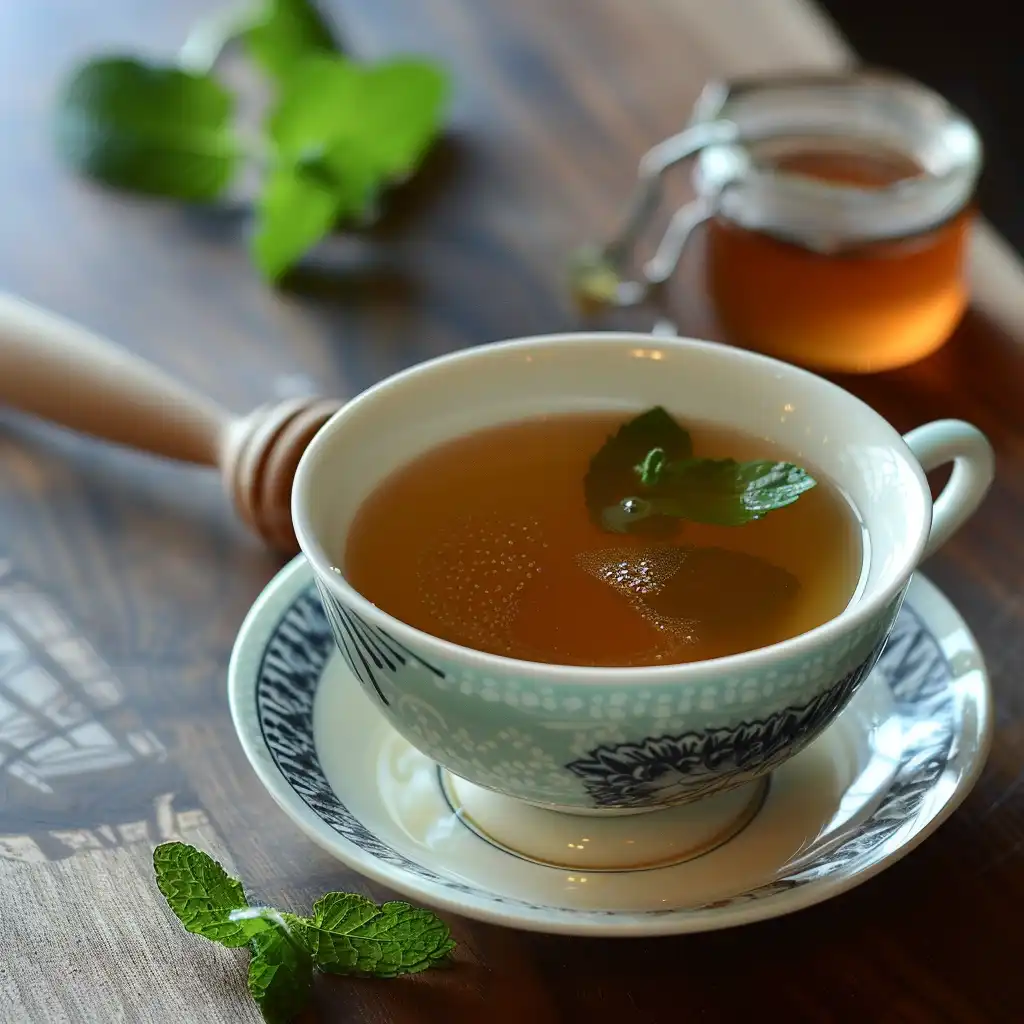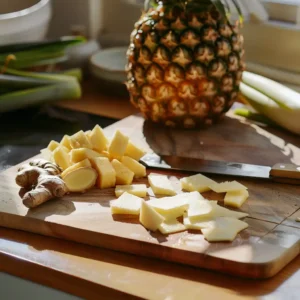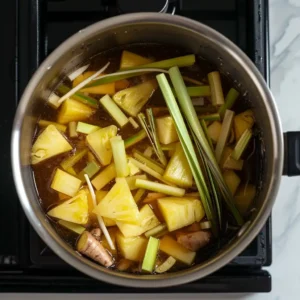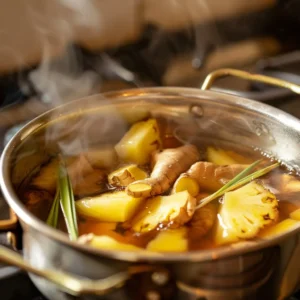There’s something magical about starting the day with a warm, healing cup of tea—especially when it’s crafted with care, using tropical ingredients that soothe the soul and support the body. Our Costa Rican tea recipe brings together vibrant pineapple, calming lemongrass, spicy ginger, and a hint of natural sweetness for a blend that feels like a gentle hug in a mug.
I stumbled upon this comforting drink during a quiet morning in San José, Costa Rica. The café was tucked between two fruit stands, the air heavy with the scent of fresh herbs and tropical flowers. A local friend insisted I try their “house tea.” I didn’t expect much—but one sip later, I was hooked. It was my first introduction to what would become my go-to Costa Rican tea recipe back home.
This isn’t just a tea; it’s a ritual. A moment of calm. And from my personal experience, this Costa Rican tea recipe is a great companion for anyone on a wellness journey. While I won’t claim it’s a miracle cure, I can say it helps me feel lighter, less bloated, and more refreshed—especially on days when my digestion feels sluggish.
The best part? It’s easy to make, caffeine-free, and naturally comforting—perfect whether you’re winding down before bed or starting your day on a healthy note. And once you try it, I have a feeling you’ll want to keep this Costa Rican tea recipe in regular rotation too.
Check out how to make lemon balm tea for weight loss if you’re looking to expand your herbal tea rotation.
Let’s dive in together and brew a cup that’s simple, soulful, and beautifully Costa Rican.
Discovering the Costa Rican Tea Recipe That Changed My Mornings
My Travel Story: How I Found Costa Rican Tea in San José
A few years ago, while wandering through San José’s Mercado Central, I found myself drawn to a small vendor selling fresh herbs bundled in banana leaves. The colors, the smells—everything about the moment was vivid and grounding. I asked the vendor what locals drank to feel good after a heavy meal, and he handed me a little paper bag of dried lemongrass, pineapple skins, and ginger pieces.
That was my introduction to the Costa Rican tea recipe—not from a hotel or fancy café, but from a local who genuinely believed in the healing power of simple ingredients. That moment shaped how I view wellness today: grounded in tradition, accessible to everyone, and deeply rooted in nature.
When I brewed that Costa Rican tea recipe back in my Airbnb kitchen, the aroma alone made me pause. It wasn’t flashy, but it was rich with character.
First Sip Impressions: Warm, Zesty, and Surprisingly Light
The first sip was everything I didn’t know I needed—warm, with a zesty kick from ginger, rounded out by the citrusy lift of lemongrass and the tropical tang of pineapple. I didn’t even add honey that first time because it didn’t need it.
Since then, this Costa Rican tea recipe has become a staple in my kitchen. It’s the drink I reach for when my stomach feels unsettled, when I want to avoid caffeine, or when I’m craving a gentle detox that’s as easy on the taste buds as it is on the body.
Looking for inspiration? Try celery cucumber ACV cooler—another favorite in my clean-drink rotation.
What Is Costa Rican Tea?
Traditional Roots and Cultural Importance
The Costa Rican tea recipe isn’t just a beverage—it’s a cultural staple passed down through generations. In Costa Rica, herbal teas are known as tés naturales and are often brewed using fresh, locally grown ingredients. These drinks aren’t just for flavor—they’re part of the country’s natural approach to wellness, often enjoyed after meals or before bed.
From conversations with locals and small herb shop owners, I learned that Costa Rican households often use what’s growing in their own backyards: lemongrass, ginger, pineapple peels, and cacao husks. These ingredients aren’t exotic to them—they’re everyday comforts. They reflect the country’s pura vida lifestyle: simple, wholesome, and in harmony with nature.
Making a Costa Rican tea recipe at home is a way of honoring that lifestyle. Drinking it isn’t a trend—it’s a tradition. A moment to slow down, connect, and care for your body using what the land provides.
Common Variations in Different Regions
While the base Costa Rican tea recipe typically includes pineapple, ginger, and lemongrass, variations abound across the country. In coastal regions, dried hibiscus flowers or fresh mint might be added for a refreshing twist. Inland, I tasted teas with bold hints of cinnamon bark or cacao shells—especially in the cooler mountain towns.
I even came across a version that added papaya leaf and orange peel, which locals shared is often used for “feeling clean from the inside out.” Some sweeten theirs with raw cane sugar; others let the pineapple do the talking.
Every family has their own spin, and that’s part of what makes the Costa Rican tea recipe so special. It evolves with the land, the season, and the person brewing it.
Check out moringa detox water for weight loss—another traditional-style drink that aligns with this natural approach.
Print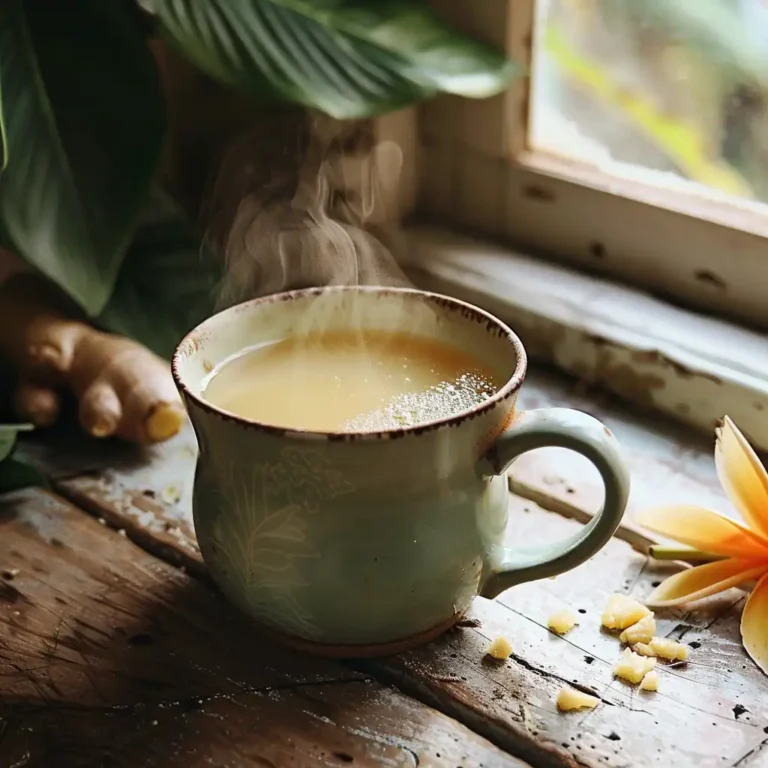
Costa Rican Tea for Weight Loss and Comfort in a Cup
A calming and tropical herbal tea featuring pineapple peel, lemongrass, and ginger—perfect for digestion, bloating relief, and caffeine-free comfort.
- Total Time: 20 minutes
- Yield: 2–3 cups 1x
Ingredients
- 1 cup fresh pineapple peel (cleaned and chopped)
- 2–3 slices fresh ginger (or 1 tsp grated)
- 1 stalk lemongrass (cut into 2-inch pieces or 1 tbsp dried lemongrass)
- 3 cups water
- 1 tsp raw honey (optional, to taste)
- Optional: 1 tbsp dried cacao shells or a cinnamon stick
- Optional Boosters:
- A few fresh mint leaves
- A squeeze of lime
- 1 tsp turmeric root (fresh or ground)
Instructions
- In a small saucepan, combine pineapple peel, ginger, lemongrass, and any optional add-ins (like cacao shells or cinnamon). Pour in the water.
Costa Rican tea simmering gently on the stove with pineapple, lemongrass, and ginger - Bring to a boil, then reduce heat and simmer for 10–15 minutes.
Cutting up fresh pineapple peel, ginger, and lemongrass for the tea base - Remove from heat and strain the tea into a mug or pitcher.
Pouring steeped Costa Rican tea through a strainer into a cozy mug - Add honey or lime if desired.
- Enjoy immediately, or let it cool and pour over ice for a tropical iced tea version.
Notes
Always scrub the pineapple peel well before using. Adjust ginger or lemongrass amounts for spicier or more citrusy flavor. Sweeten after it cools slightly to preserve honey benefits. Tea stores well in the fridge for 2–3 days.
- Prep Time: 5 minutes
- Cook Time: 15 minutes
- Category: Drink
- Method: Stovetop
- Cuisine: Costa Rican
Nutrition
- Serving Size: 1 cup
- Calories: 25
- Sugar: 3g
- Sodium: 1mg
- Fat: 0g
- Saturated Fat: 0g
- Unsaturated Fat: 0g
- Trans Fat: 0g
- Carbohydrates: 6g
- Fiber: 1g
- Protein: 0g
- Cholesterol: 0mg
Costa Rican Tea Recipe (Step-by-Step Guide)
Ingredients You’ll Need
To make the traditional Costa Rican tea recipe I brought home from my travels, you’ll need just a handful of nourishing, natural ingredients. Most are easy to find in grocery stores or farmer’s markets:
- 1 cup fresh pineapple peel (cleaned and chopped)
- 2–3 slices fresh ginger (or 1 tsp grated)
- 1 stalk lemongrass (cut into 2-inch pieces or 1 tbsp dried lemongrass)
- 3 cups water
- 1 tsp raw honey (optional, to taste)
- Optional: 1 tbsp dried cacao shells or a cinnamon stick
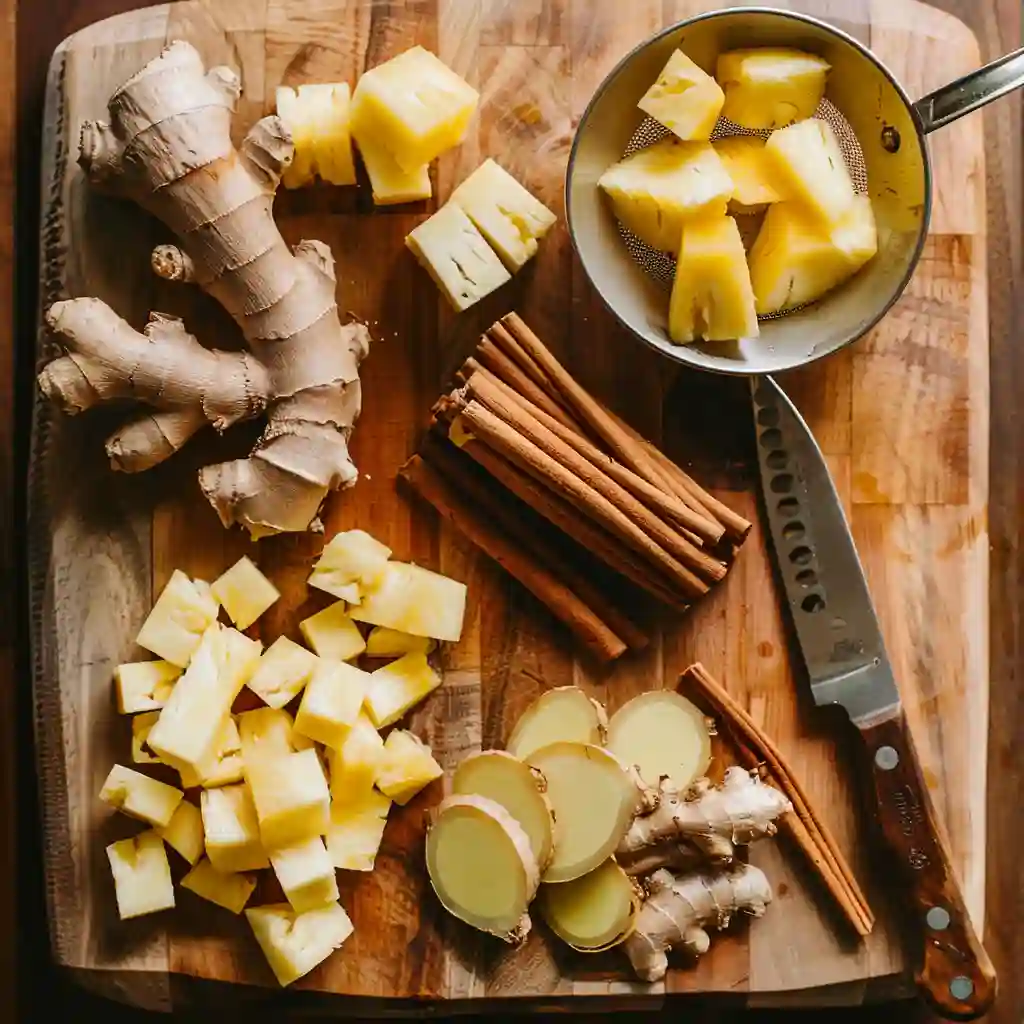
Optional Boosters (I add these depending on my mood):
- A few fresh mint leaves
- A squeeze of lime
- 1 tsp turmeric root (fresh or ground)
When I first tried the Costa Rican tea recipe, I was surprised at how versatile it could be. You can keep it simple or build on it with add-ins to suit your taste or wellness goals.
Simple Instructions to Brew It Right
- Boil the base
In a small saucepan, combine pineapple peel, ginger, lemongrass, and any optional add-ins (like cacao shells or cinnamon). Pour in the water. - Simmer gently
Bring to a boil, then reduce heat and simmer for 10–15 minutes. This helps the flavors meld into a balanced, aromatic infusion. - Strain and sip
Remove from heat and strain the tea into a mug or pitcher. Add honey or lime if desired. - Serve warm or chill
Enjoy immediately, or let it cool and pour over ice for a tropical iced tea version. That’s one reason I love this Costa Rican tea recipe—it’s good hot or cold, day or night.
Personal Tips for Flavor & Balance
- Keep the peel clean: Always scrub the pineapple peel well before using. Organic is best if available.
- Adjust to your taste: If you like a spicier tea, increase the ginger. Want it more citrusy? Add extra lemongrass or orange peel.
- Sweeten last: Let the tea cool slightly before adding honey. That preserves its raw benefits.
- Make a batch: I often double the recipe and store it in the fridge for 2–3 days. The Costa Rican tea recipe keeps its flavor really well and is especially refreshing when served over ice.
Trying different variations of the Costa Rican tea recipe keeps it exciting. It’s a small way to nourish your body while sticking to something familiar and easy.
Don’t miss our kefir weight loss drink—it’s a gut-friendly drink that complements this tea beautifully.
Ingredient Spotlight: Why These Work So Well
Pineapple: The Tropical Star That Supports Digestion
I’ve always loved pineapple, but I never realized the peels—usually tossed away—held so much value until I saw locals in Costa Rica boil them into tea. The natural enzymes, especially bromelain, have been traditionally used to support digestion and reduce bloating. It adds a subtle tropical sweetness that makes the Costa Rican tea recipe both delicious and functional.
The aroma of simmering pineapple peel always brings me back to open-air kitchens and warm mountain breezes. That tropical scent has become a comforting part of my routine every time I revisit the Costa Rican tea recipe.
Ginger & Lemongrass: Spicy Meets Soothing
Ginger is my go-to for almost everything—upset stomach, chilly days, or when I need a little internal fire. In this blend, it provides a gentle kick that balances the sweet pineapple.
Lemongrass, on the other hand, brings calm. It’s citrusy, slightly floral, and has a natural way of refreshing the body and mind. In Costa Rica, it’s commonly brewed as “té de zacate limón” and sipped after meals.
Together, these two ingredients form the heart of the Costa Rican tea recipe, creating a warming, soothing, and grounding base that’s hard to beat.
Cacao Shells: A Costa Rican Super-Secret
On my second trip to Costa Rica, a cacao farmer handed me a small bag of dried cacao shells and said, “Try this in your tea.” I did—and never looked back. The shells add a rich, earthy aroma with a hint of chocolate, and according to locals, it’s been associated with relaxation and mood support.
It’s one of those special touches that elevate the Costa Rican tea recipe into something truly memorable and unique.
Optional Add-Ins: Honey, Mint, or Cinnamon
Some days, I like a touch of honey for its comforting sweetness and immune-supporting reputation. Other times, a sprig of mint brings freshness. And when I’m brewing this before bed, I toss in a cinnamon stick for warmth and depth.
These additions aren’t just about taste—they reflect the adaptability of this Costa Rican tea recipe to your body and mood. It’s easy to personalize, which is one reason I love making it regularly.
Check out berry basil detox drink—another plant-based option that layers flavor with function.
Health Benefits of Costa Rican Tea (From My Experience)
A Light Detox: Feeling Less Bloated
From the first week I started drinking the Costa Rican tea recipe regularly, I noticed one major thing—it helped me feel lighter. I often make a cup after dinner, and I’ve found that it may gently support digestion and reduce that heavy, sluggish feeling I sometimes get after meals.
It’s not about drastic changes. For me, it’s about creating a rhythm that feels right. This tea has become a soothing part of that process, and it’s why I keep the Costa Rican tea recipe in my weekly routine.
Morning Warmth and Energy Without Caffeine
I used to rely on coffee first thing in the morning. But some days, it left me jittery or just too wired. Swapping it for this Costa Rican tea recipe gave me a calmer, more sustained sense of alertness. Ginger and lemongrass warm me up from the inside out, and the pineapple adds a natural zing that feels like energy—just without the caffeine crash.
There’s something about starting the day with a warm mug of this blend that sets the tone. I find the Costa Rican tea recipe gives me just the right amount of comfort without the jitters.
May Support Immune System and Gut Health
While I’m not a medical professional, I can tell you that I rarely get colds when I’m consistent with this tea. Ingredients like ginger and honey have long been associated with immune-supporting properties, and pineapple peel has a gentle cleansing effect that seems to help keep things moving.
Some friends who tried the Costa Rican tea recipe after big meals told me it helps them feel less bloated and more regular. Again, no magic here—just a smart, natural combo of traditional ingredients.
Why It Helps Me Avoid Late-Night Cravings
One unexpected benefit? When I drink this tea in the evening, I’m less likely to raid the fridge at midnight. The warm, full-bodied flavor satisfies me emotionally—like a treat that’s also good for me. And because it’s naturally sweetened by pineapple, I don’t feel the need to reach for sugary snacks.
If you’re craving something fun and different, don’t miss our tea with sprite—a curious twist on tea for when you’re in the mood for something bubbly yet herbal.
Costa Rican Tea for Weight Management
Why I Drink This Tea Before Bed
My evening routine isn’t complete without a cup of this Costa Rican tea recipe. Over time, it became a habit—not because someone told me it would “burn fat overnight,” but because I felt better when I ended my day with it. The warm blend of pineapple peel, ginger, and lemongrass is naturally calming and may support digestion just when I need it most.
This Costa Rican tea recipe has become my gentle way of saying to my body, “We’re done eating, now let’s rest and reset.”
Belly Fat and Bloating: What Changed for Me
Now let me be clear—I don’t believe in miracle teas. But I do believe in habits. And from my experience, drinking the Costa Rican tea recipe regularly—especially at night—has helped me feel less bloated and more in tune with my body. I wake up with a flatter stomach, and I credit that to fewer late-night cravings and improved digestion.
The ingredients may not “melt fat,” but they can help reduce water retention and make you feel lighter, which is a big win in my book. That’s one of the reasons I keep returning to the Costa Rican tea recipe again and again.
Herbal Support vs Quick Fixes: What to Expect
I’ve tried quick fixes. They didn’t work. What did work? Simple, consistent rituals like this Costa Rican tea recipe. It’s not magic, but it’s sustainable.
This tea supports the kind of wellness I believe in—gentle, daily choices that add up over time. There’s no caffeine, no additives, no harsh ingredients. Just real, whole plant parts doing their thing.
Discover great ideas like how to make lemon balm tea for weight loss if you’re interested in building more of these quiet rituals into your day.
Serving Suggestions: Hot or Iced?
Refreshing Iced Costa Rican Tea Recipe
On warm afternoons, I love turning the Costa Rican tea recipe into a chilled tropical refresher. After brewing, I let the tea cool to room temperature, pour it over ice, and sometimes toss in a few slices of orange or cucumber for added brightness. The ginger and lemongrass stay bold, while the pineapple brings that sunny, fruity vibe.
It’s perfect for sipping while reading outside or cooling off after a workout. I often prep a larger batch of the Costa Rican tea recipe and store it in a mason jar in the fridge—it holds up beautifully for a couple of days and tastes even better cold.
Cozy Bedtime Version for Cold Nights
When the nights get chilly, nothing beats this Costa Rican tea recipe served warm in my favorite ceramic mug. I add a cinnamon stick during the simmer and drizzle in a touch of raw honey after it cools a bit. Sometimes I’ll even steep a mint leaf to make it extra soothing.
This is the version I reach for when I want to relax before bed or settle my stomach after a rich dinner. It’s become such a comforting ritual, I can’t imagine my evenings without it.
Pairings: What to Enjoy It With
Whether iced or warm, this Costa Rican tea recipe pairs nicely with light snacks or breakfast bites. Here are a few of my favorites:
| Best Time | Food Pairing |
|---|---|
| Morning | Banana oatmeal muffins or chia pudding |
| Afternoon | Cucumber sandwiches or a handful of nuts |
| Evening | A piece of dark chocolate or sliced papaya |
You can truly pair the Costa Rican tea recipe with your mood, your moment, or your meal—it’s incredibly versatile and always satisfying.
Check out iced teddy graham latte if you’re into creative ways to cool down with flavor.
FAQs: Costa Rican Tea Questions Answered
What is Costa Rican tea?
Costa Rican tea is a traditional herbal infusion made using local ingredients like pineapple peel, ginger, lemongrass, and sometimes cacao shells. Known for its light tropical flavor and digestive support, it’s commonly enjoyed after meals or before bed. Each region and family puts their own twist on it, making it a flexible and meaningful part of Costa Rican culture.
How do you make tea before bed for fat burning?
My go-to bedtime tea for gentle fat-burning support includes ingredients like pineapple peel, fresh ginger, and lemongrass. I simmer these in water for about 15 minutes, then add honey or cinnamon depending on the mood. This blend may help reduce bloating and support digestion, helping you wind down without added calories or stimulants.
What tea can I make to lose belly fat?
While no tea can directly “melt belly fat,” herbal blends like this Costa Rican tea or options with lemon balm, ginger, and mint can support hydration, reduce bloating, and help manage cravings. Personally, I found drinking tea instead of snacking at night makes a difference over time. Don’t miss our kefir weight loss drink for another belly-friendly option.
How to make Costa Rican cacao tea?
To make a Costa Rican cacao tea, add 1 tablespoon of dried cacao shells to your base Costa Rican tea recipe (pineapple peel, ginger, lemongrass). Let it simmer along with the other ingredients. The cacao adds a naturally chocolatey, earthy aroma that pairs beautifully with the citrus and spice notes. It’s especially cozy on cool evenings.
Final Thoughts: Why I Keep Coming Back to This Tea
My Evening Ritual and What It Means to Me
Every evening, after the kitchen is clean and the day is winding down, I stand by the stove and watch the steam rise from my pot of Costa Rican tea. There’s something grounding about the ritual—something that pulls me back into the moment. It’s not just about health. It’s about connection—to travel memories, to nature, and to myself.
This tea reminds me to slow down. To choose simple ingredients. To care for my body with gentle habits instead of quick fixes.
And the truth is, it’s delicious. Warm or iced, sweetened or plain, it just works.
Try It and Share Your Version with Me
If you’re looking for a natural way to reset, to nourish, or simply to treat yourself to a delicious moment, I truly recommend trying this Costa Rican tea recipe. Start with the basics, then add your own twist—maybe a cinnamon stick, maybe cacao, maybe even fresh basil.
Let it be your cup of comfort.
Don’t miss our detox soup recipes for weight loss if you’re building a clean and cozy evening routine like mine.
And if you try this tea, tag me or message me—I’d love to hear what you added or how it made you feel.
This recipe is shared for informational purposes and is not a substitute for medical advice.
Follow me on Pinterest: heartlyrecipes on Pinterest
Or say hello on Facebook: my FB page
